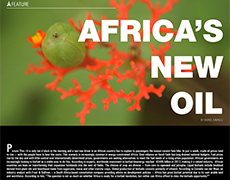“…traditional kolanut is regarded as a sacred nut, which is used to communicate with the gods being that it was chosen by the elders as the head or king of all seeds…”
Origins and History
Kola nut is the seed kernel of a large African tree grown commercially around the world, particularly in Nigeria, Sri Lanka, Indonesia, Brazil and other parts of South America. It is extremely popular amongst the inhabitants as a caffeine-containing stimulant. The nuts are eaten whole or powdered and mixed with liquid for a drink. The kola nut is primarily derived from three species from the cocoa tree family: Cola acuminta, Cola nitida and Cola vera, which originate in tropical West Africa but can also be found in pockets of Brazil and the West Indies, where they were taken by the slave trade. The trees typically reach a height of 25 meters or 60 feet and its waxy oval leaves frame cheerful star-shaped flowers that are white or yellow with purple accents. Its fruit is pod-shaped, with each of which is nestled about a dozen roundish shaped seeds or kola nuts. The kola nuts may be red, white or pinkish of hue. (Once opened, the exposed seedpod’s arrangement looks rather similar in its configuration to an armadillo’s armour!). The nut’s aroma is sweet and rose-like; and the first taste is bitter, but sweetens upon chewing. The nut can be boiled to extract the cola.
The Many Roles of the Kola Nut
Its versatility as a symbol, medicine, food and flavoring has been long been utilized around the world since ancient times and continues to be so applied. Science has isolated certain compounds within it, which can be credited with its medicinal benefits.
Symbolic Uses: As a symbol it is used in West Africa by the Igbos of Nigeria to grace social rituals of hospitality as welcome offerings to guests; as sacred offering in religious rites and prayers; in ancestor veneration; and in important life events such as weddings, naming ceremonies, funerals and memorials. As a mark of respect the kola nut is broken with knife. Prayer follows the presentation of kola nut immediately, which in traditional pattern is libations. In the prayer our forefathers are beaconed to come and participate in the eating of the kola nut and to guide and protect in the mission that brings the people together. After the prayer, the kola nut is broken, shared, every body eats and the ceremony begins.
“…In May of 1886, Dr. John Styth Pemberton, a pharmacist from Georgia, USA, took extracts of the kolanut and coca, mixed them with sugar, carbonated water and caramel coloring to create the first Coca-Cola recipe…”
The presentation of the kola nut is crucial in that even when a visitor comes to someone’s home, the guest will not say his mission until after the kola nut has been presented to him. Traditionally kola nut is regarded as a sacred nut, which is used to communicate with the gods being that it was chosen by the elders as the head or king of all seeds. The Yorubas of Nigeria apply the kola nut in a special form of divination known as Obi divination, in which the diviner asks the spirits a question and throws four pieces of kola nut. The way the kola nuts land are interpreted by the diviner as the answer to his or her question. In the olden days it took awhile before kola is broken. The reason is that kola nut used by tradition is multi-cotyledon. As such every kola nut has meaning despite the fact that the person who presents the kola nut does not check how many divisions a kola nut has by nature. Nonetheless the elder must check each kola nut and interpret their meanings before they are finally broken. As the saying goes “the words of elders are words of wisdom.” While in most cases their interpretation are regarded as superstitious, they are said to turn out correctly.
Medicinal Uses: The kola nut is high in caffeine as well as a number of other phyto-chemical compounds including betaine (a natural red pigment), kola red, phenolics, tannins, theobromine and theophylline. Its bitter astringent flavor is used as digestive aid prior to meals to stimulate gastric juice and bile production; while its caffeine and theobromine content make it a potent neuro-stimulant that is used to combat fatigue. The nut and its extracts have been also successfully used in treating respiratory conditions such as asthma and whooping cough as its caffeine, theobromine and theophylline content act as vasodilators that dilate the blood vessels, allowing for greater circulation of oxygen. Other medicinal uses include the treatment of toothache, diarrhea, exhaustion, headaches, hunger (the caffeine content means it is an effective appetite suppressant), malaria, nausea, poison antidote, sedative, stimulant and tonic.
“…the kolanut is still used as a type of aperitif prior to meals to enhance the taste of the food to follow, as its astringency cleanses the palate…”
As Food and Flavoring For Drinks
You will find often West African manual workers, laborers and farm workers chewing kola as they go about their daily work as a pep-me-up in between meals, although the practice is said to be dwindling amongst the younger generation. Nonetheless, the kola nut is still used as a type of aperitif prior to meals to enhance the taste of the food to follow, as its astringency cleanses the palate and stimulates saliva production. Nutritionally, it is a source of some B-vitamins (thiamine, riboflavin, niacin), as well as proteins, starch and sugar. Muslims in Africa often substitute it for alcohol as their religion forbids them to drink and, although it contains 1-3.5% caffeine, it is not addictive. It is the distinctive source of flavor for colas, and certain soft drinks and tonics. In May of 1886, Dr. John Styth Pemberton, a pharmacist from Georgia, USA took extracts of the kolanut and coca, mixed them with sugar, carbonated water and caramel coloring to create the first Coca-Cola recipe. Since then it has been used as flavoring in many other soft drinks - although Coca-Cola purportedly does not used kola nut anymore, but uses instead synthetic derivatives that mimic its flavors.
Regular daily chewing of the kola nut can stain the teeth giving a telling rusty color. According to medical science, kola nut does have a high level of nicotine, which can affect body chemistry negatively. It can lead to insomnia, high blood pressure, high heartbeat, high-level toxicity, over stimulations and locomotive effects. However, despite some of these negative medical reports, the kolanut is a cherished commodity that has blossomed into a huge economic prospect which kolanut trade with exportation to China, North America and India, where it is largely required for the production of cola drinks and pharmaceutical products.



